

EEG Signal Processing for Dummies. EEG Signal Processing for Dummies As promised in my previous post about Event-Related Potentials, I will explain the basics and standard steps commonly used in the analysis of EEG signals.
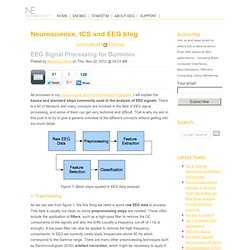
There is a lot of literature and many concepts are involved in the field of EEG signal processing, and some of them can get very technical and difficult. That is why my aim in this post is to try to give a general overview of the different concepts without getting into too much detail. Figure 1: Basic steps applied in EEG data analysis 1. As we can see from figure 1, the first thing we need is some raw EEG data to process. 2. The next step could be considered the most important one: feature extraction. There are other feature extraction methods that are worth mentioning, such as EEG tomography, that allows us to compute the regions inside the brain that are active (applying the so-called inverse-problem approach).
Figure 2: Example of a graph. 3. OpenBCI. Tools. Smartphone Brain Scanner. Open source neural activity monitors. Links. Los hábitos se forman cuando ondas cerebrales son lentas. Este es un post para que juzguen ustedes...
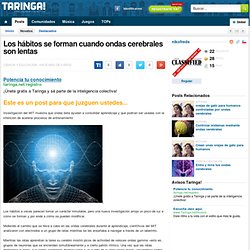
Investigación del MIT muestra que ondas beta ayudan a consolidar aprendizaje y que podrían ser usadas con la intención de acelerar procesos de entrenamiento Los hábitos a veces parecen tomar un carácter inmutable, pero una nueva investigación arroja un poco de luz a cómo se forman y por ende a cómo se pueden modificar. Práctico lector de ondas cerebrales. Una de las primeras empresas en presentar dispositivos con interfaces cerebro-computadora (BCI) para videojuegos basados sobre la tecnología utilizada en la electroencefalografía (EEG) fue la australiana Emotiv Systems.
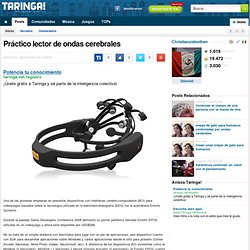
Durante la pasada Game Developers Conference 2008 demostró su primer periférico llamado Emotiv EPOC utilizado en un videojuego y ahora está disponible por USD$299. No se trata de un simple diadema con electrodos para jugar con un par de aplicaciones, ese dispositivo cuenta con SDK para desarrollar aplicaciones sobre Windows y varios aplicaciones desde el sitio para probarlo (Cortex Arcade, Neurokey, Mind Photo Viewer, NeuroVault, etc). Meditation Training and Neurofeedback Using a Personal EEG Device. Approach is a better one when data classes are unbalanced,as it samples in proportion to class size.
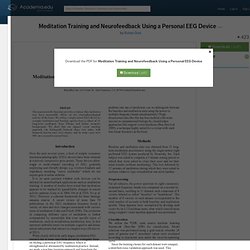
A five-fold crossvalidation was used in which four-fifths of the data wasused for training the SVM, while the remaining fifth wasleft as test data. This process was repeated five times to provide average balanced classification accuracies for eachdataset. Results We find our classification approach is able to distinguish between the baseline and meditation state on a second-by-second basis with a mean balanced success rate of 75.7%.The histogram of each subject's individual balancedsuccess rate is included below.
Histogram of the balanced success rates of the SVM for eachlong-term meditation practitioner after model selection (MS) and5-fold cross-validation. In the best cases, we are able to classify with over 90%accuracies and with areas under the ROC of 0.940. A sample ROC curve (0.940) from the subject with the highest balanced success rate ( from the sample population. Conclusion. EMOTIV INSIGHT EEG for Gaming, Meditation, Self-Criticism Sessions, Now on Kickstarter; Interview with Tan Le, Founder and CEO. 21inShare Emotiv Lifesciences, one of the leading companies trying to introduce electroencephalography (EEG) for consumer use, has unveiled its next generation headset and is now raising money on Kickstarter to fund its commercialization.

The EMOTIV INSIGHT is a slicker, lighter device compared to the company’s previous products and features a 5 channel EEG plus two reference sensors, wireless connectivity, and new electrodes that don’t require a gel or any other wetting. Here’s Emotiv Lifescience’s video introducing the INSIGHT: Shiv Gaglani, Medgadget: What inspired the development of the Emotiv Insight? Tan Le, Founder and CEO of Emotiv Lifesciences: The inspiration to develop the Emotiv Insight came from our desire to empower ourselves and others to understand their own brain and gain insights into how to improve their own cognitive fitness and performance.
Using EEG for meditation training [quantified self] EEGmeditation. Forthcoming, Science and Consciousness Review.
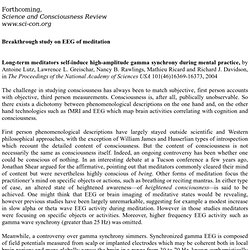
Aviso de redirección. Electroencefalograma. EEG / Brain Machine Interfaces « Medical and Health Related Projects with Arduino. It is is very clear that EEG sensors and headsets are becoming more commercialized and thus accessible to users for building custom brain machine interfaces with various functionalities from switching TV channels to controlling wheelchairs as in this case: The parts of this system include an electric wheelchair, a laptop computer, an Arduino, an interface circuit, an EEG headset, and a collection of ready-made and custom software.
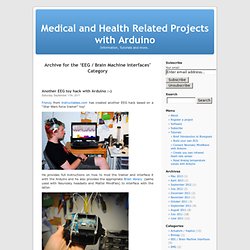
The software which was written specifically for this project (including the GUI and Arduino sketch) has been bundled with Puzzlebox Brainstorms, and is released freely under an Open Source license. The EEG headset, which connects wirelessly to the laptop, allows the operator to simply think “forward” or “left” or “right” to cause the wheelchair to move. Performance is related to practice by the user, proper configuration of the software, and good contact made by the EEG electrodes on the scalp of the operator.
Buying an affordable EEG device. I would like to control to some extent the robotic movement of something I'm building using EEG readings, basically developing a brain-computer-interface.

The price for EEG equipment that I've found so far is very expensive (roughly £1000) Would anyone know about more affordable EEGs or alternative methods of measuring brain signals? I don't know crap about this but I am happy to do some research as it is interesting. OK, what is the technique for EEG? In conventional scalp EEG, the recording is obtained by placing electrodes on the scalp with a conductive gel or paste, usually after preparing the scalp area by light abrasion to reduce impedance due to dead skin cells. O hacer un hack a un dispositivo EEG con Arduino. EEG With an Arduino - chipstein. Getting all the way down to the 1 Hz frequency range of EEG requires communication through a digital port; in the current era this would be a USB connector.
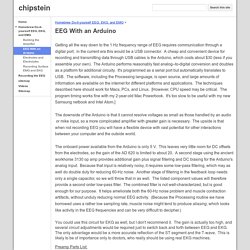
A cheap and convenient device for recording and transmitting data through USB cables is the Arduino, which costs about $30 (less if you assemble your own). The Arduino performs reasonably fast analog--to-digital conversion and doubles as a platform for additional circuity. It's programmed as a serial port but automatically translates to USB. The software, including the Processing language, is open source, and large amounts of information are available on the internet for different platforms and applications. The techniques described here should work for Macs, PCs, and Linux. Siri pasa de reconocedor de voz a lector de mentes. Sónar 2013: desde las ondas sonoras a los ondas cerebrales en 20 años >> El arte en la edad del silicio. El proyecto no consiste en controlar de manera directa el proceso mecánico, sino de definir patrones gráficos que luego se trasladan a una máquina tricotosa.

Open Source Brain Computer Interface for Arduino. By on December 20, 2013Posted in: technologyTags: Arduino, brain-computer interface, open-source, OpenBCI OpenBCI enables makers to get in to the fascinating field of mind controlled devices. Consumer grade BCI’s like the NeuroSky Mindwave and Emotiv EPOC have been available on the market for quite some time now and used for innovative applications like brain controlled games, skate boards and multitasking aides. However, these neuroheadsets are proprietary devices with limited access to the hardware and source code. OpenBCI creators Joel Murphy and Conor Russomanno developed an open source BCI because they believe the future of brain research and mind controlled devices should not be in the hands of a few companies and scientists but open to anyone who is interested. They are now running a crowfunding campaign on Kickstarter to start mass producing the boards.
OpenBCI: An Open Source Brain-Computer Interface For Makers by Joel Murphy & Conor Russomanno. In addition to EEG circuit design, we’ve been busy attacking the EEG headwear design challenge from an entirely new angle. Throughout the design process, our goal has been to find a solution that is truly customizable while still taking into account cost, comfort, and signal quality. The reason we think customizability is such a key to the advancement of BCI is because the field is very new and evolving so quickly; there are still so many unknowns in other aspects of the overall BCI design challenge.
Low-cost BCI research and development should not be limited by fixed electrode systems that require you to repeatedly sample data from the same regions of the scalp. OpenBCI. EEG Headset.